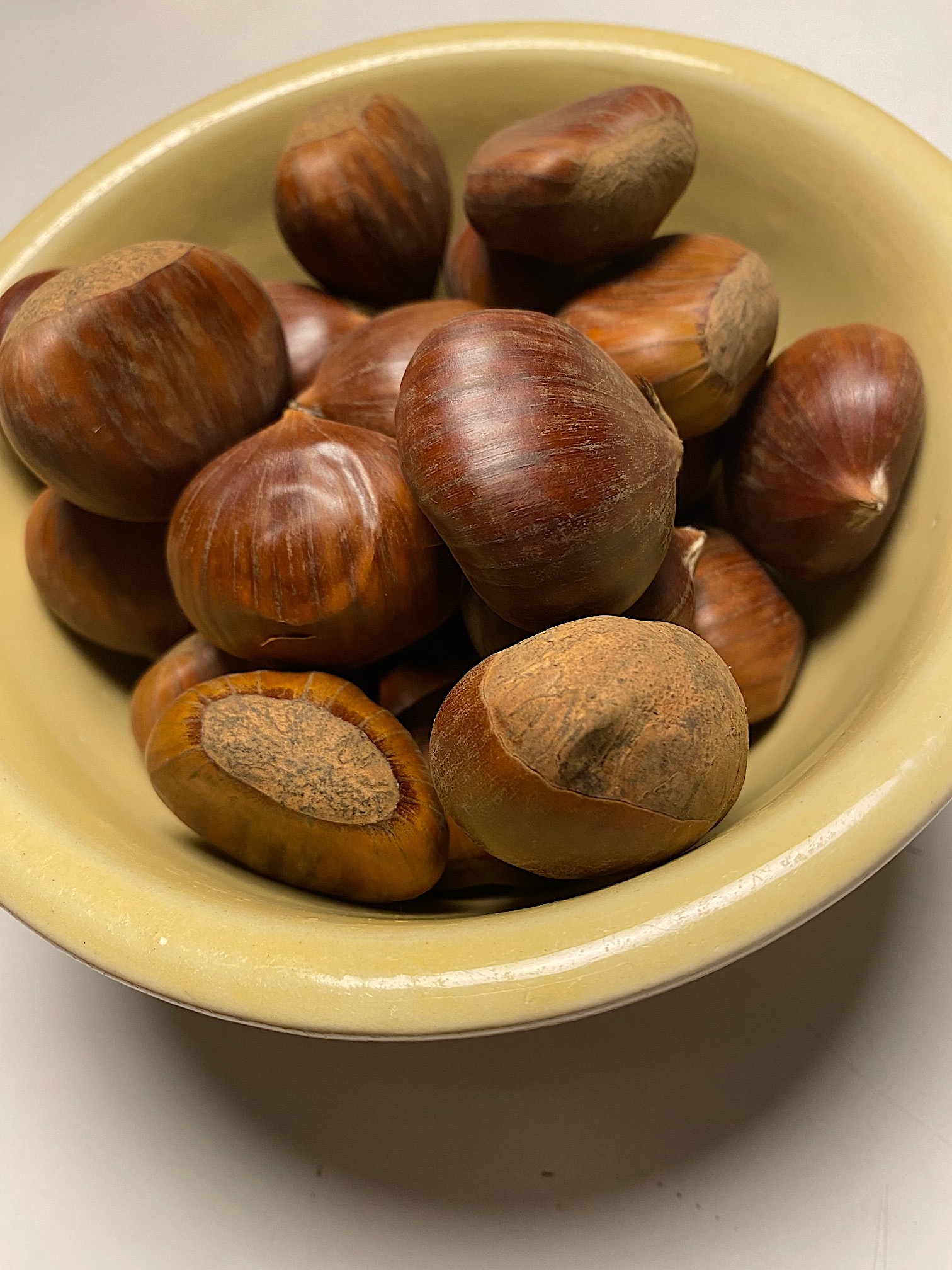MARIANI’S
Virtual Gourmet
December 4,
2022
NEWSLETTER
IN THIS ISSUE
JAMES BOND'S TASTES:
THE SPY WHO LOVED ME
By John Mariani
NEW YORK CORNER
HINOKI GREENWICH
By John Mariani
ANOTHER VERMEER
CHAPTER 47
By John Mariani
NOTES FROM THE WINE CELLAR
THE WINES OF PUGLIA
By John Mariani
❖❖❖
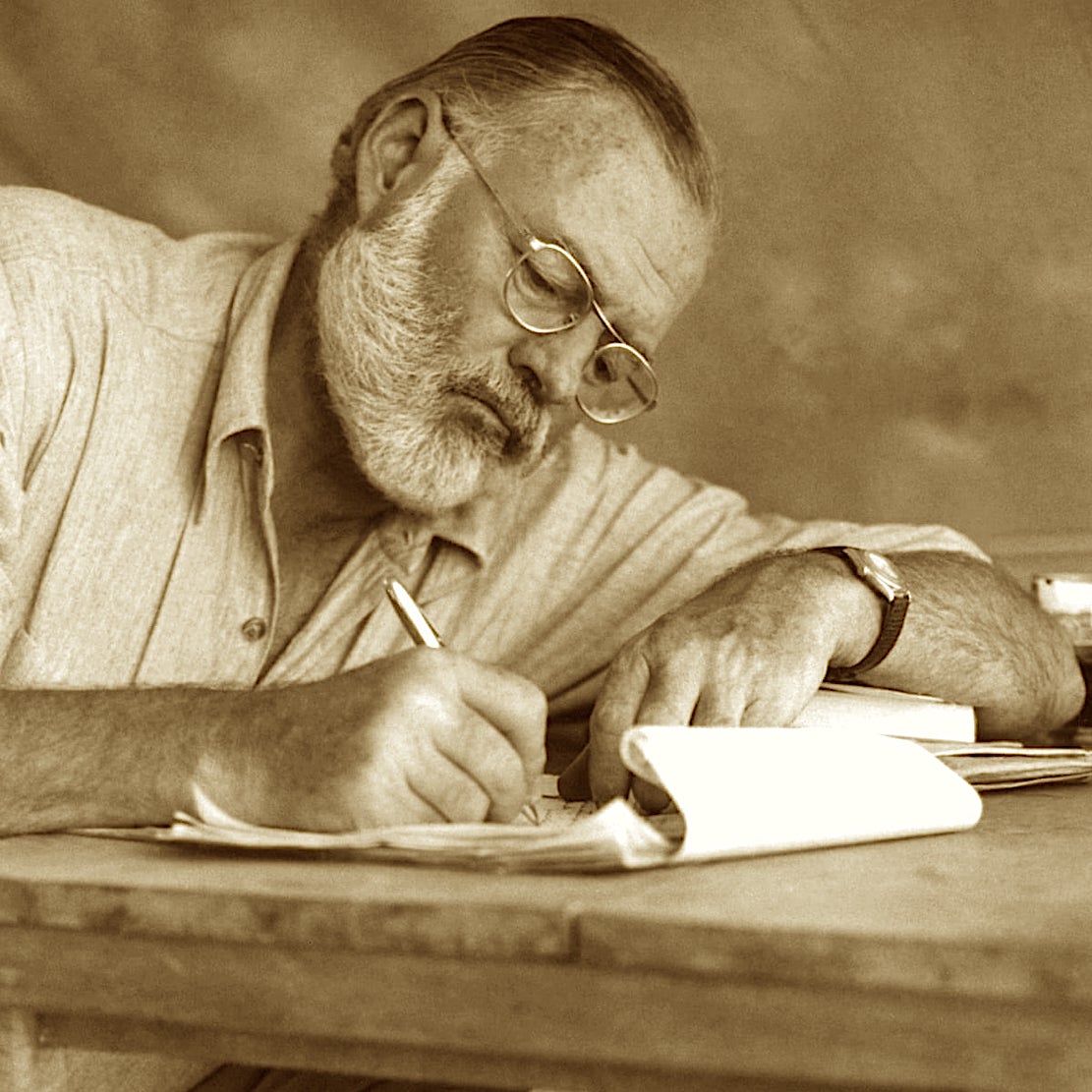 biographer
Mary Dearborn on Part 2 of "Ernest
Hemingway: A Life." Go to: WVOX.com.
The episode will also be archived at: almostgolden.
biographer
Mary Dearborn on Part 2 of "Ernest
Hemingway: A Life." Go to: WVOX.com.
The episode will also be archived at: almostgolden.
JAMES BOND'S
TASTES:
THE SPY WHO LOVED ME

Ian Fleming’s 1962
James Bond novel, the ninth in
the series, was his own least
favorite, for its experimental
first person narrative of a
Canadian woman whom Bond—who
shows up two-thirds of the way
in—eventually saves from thugs
was not his forte. It received
poor reviews and Fleming
refused to sell the story to
the Bond filmmakers, allowing
them only to buy the title.
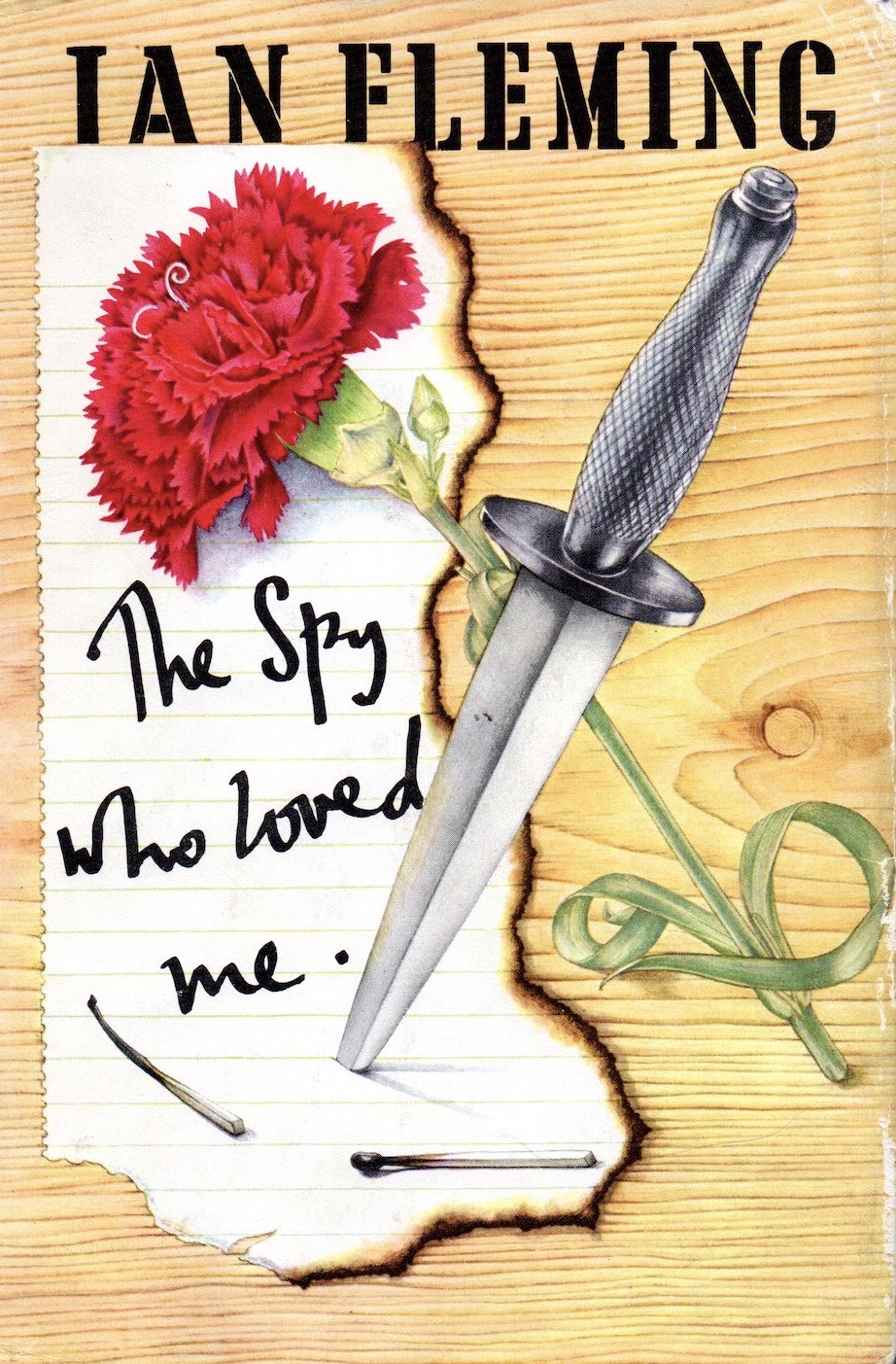 The
book’s plot has Viv Michel
reminiscing about failed love
affairs and an abortion she’d had
in Switzerland. She travels
through the Adirondacks on her way
back to her Canadian home,
checking into a motel two mobsters
intend to set on fire to collect
insurance money, with her inside.
Bond appears on the scene only
because, while on his way to
Toronto to pick up a defecting
nuclear scientist, he gets a flat
tire near the motel.
The
book’s plot has Viv Michel
reminiscing about failed love
affairs and an abortion she’d had
in Switzerland. She travels
through the Adirondacks on her way
back to her Canadian home,
checking into a motel two mobsters
intend to set on fire to collect
insurance money, with her inside.
Bond appears on the scene only
because, while on his way to
Toronto to pick up a defecting
nuclear scientist, he gets a flat
tire near the motel. 
Bond manages to kill the
mobsters, named Sluggsy and
Horror, then sleeps with Viv,
leaving a goodbye note to her the
next morning. Nothing in the short
novel has anything to do with
Bond’s tastes. There are only
glancing references to Viv
enjoying some pink Champagne, foie
gras, caviar, spaghetti
“bolognaise,” egg-and-bacon
sandwiches and a bottle of
Kentucky Gentleman bourbon.
Neither does the book’s
plot have anything to do with the
movie, the tenth in the series,
which came out in 1977, starring
Roger Moore in his third turn as
007. Given the success of previous
Bond films, The
Spy Who Loved Me had a huge
$13.5 million budget and
involved many international
locations. It went on to gross
$185.4 million worldwide.
 In
the movie, Bond investigates the
disappearance of two submarines,
one British, the other Soviet. In
Austria, he is almost killed by
Soviet agents skiing down a
mountain. He is next in Egypt to
find who is selling a sub tracking
system. There he meets the
beautiful Anya
Amasova, KGB agent Triple X
(Barbara Bach), and encounters the
fearsome Jaws (Richard Kiel), a
giant with steel teeth.
In
the movie, Bond investigates the
disappearance of two submarines,
one British, the other Soviet. In
Austria, he is almost killed by
Soviet agents skiing down a
mountain. He is next in Egypt to
find who is selling a sub tracking
system. There he meets the
beautiful Anya
Amasova, KGB agent Triple X
(Barbara Bach), and encounters the
fearsome Jaws (Richard Kiel), a
giant with steel teeth.
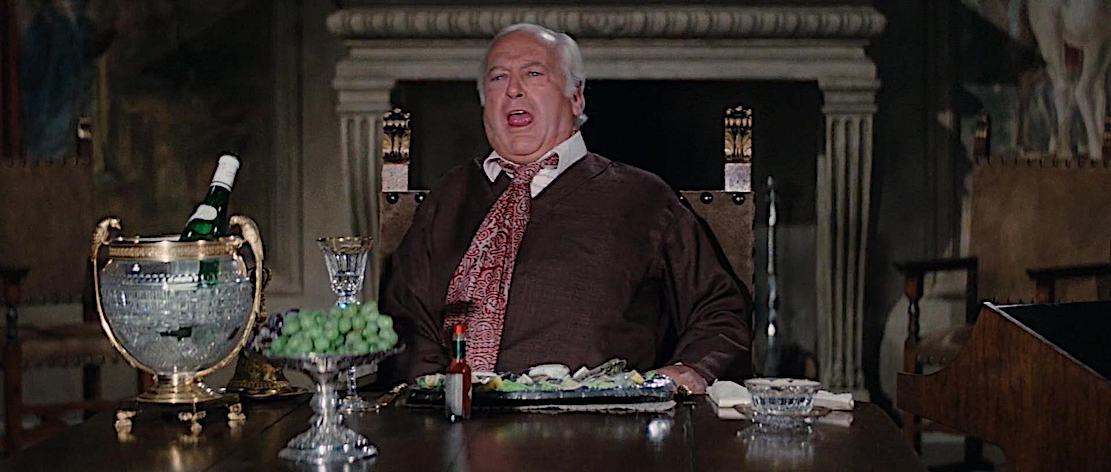
Together 007 and Triple X
travel to Sardinia to find a
shipping magnate named Karl
Stromberg (Kurt Jürgens), who had
recently launched a gigantic
supertanker, the Liparus, on which
he is seen having a lavish meal of
lobster, stone crabs, oysters,
poached fish and Champagne, along
with a bottle of Tabasco.
Bond
and Anya must escape Jaws, who is
on a motorcycle, and another
assassin, Naomi (Caroline Munro),
in an attack helicopter.
They escape in a Lotus
Esprit that Q Branch
has converted to drive
underwater.
Anya discovers that Bond
had killed her lover, so she vows
to kill Bond, as soon as their
mission is complete. They board a
submarine to track the Liparus, but are
captured by the crew of the
tanker, from which Stromberg plans
to launch nuclear missiles from
the captured British and Soviet
submarines to obliterate Moscow
and New York, which would trigger
a global nuclear war.
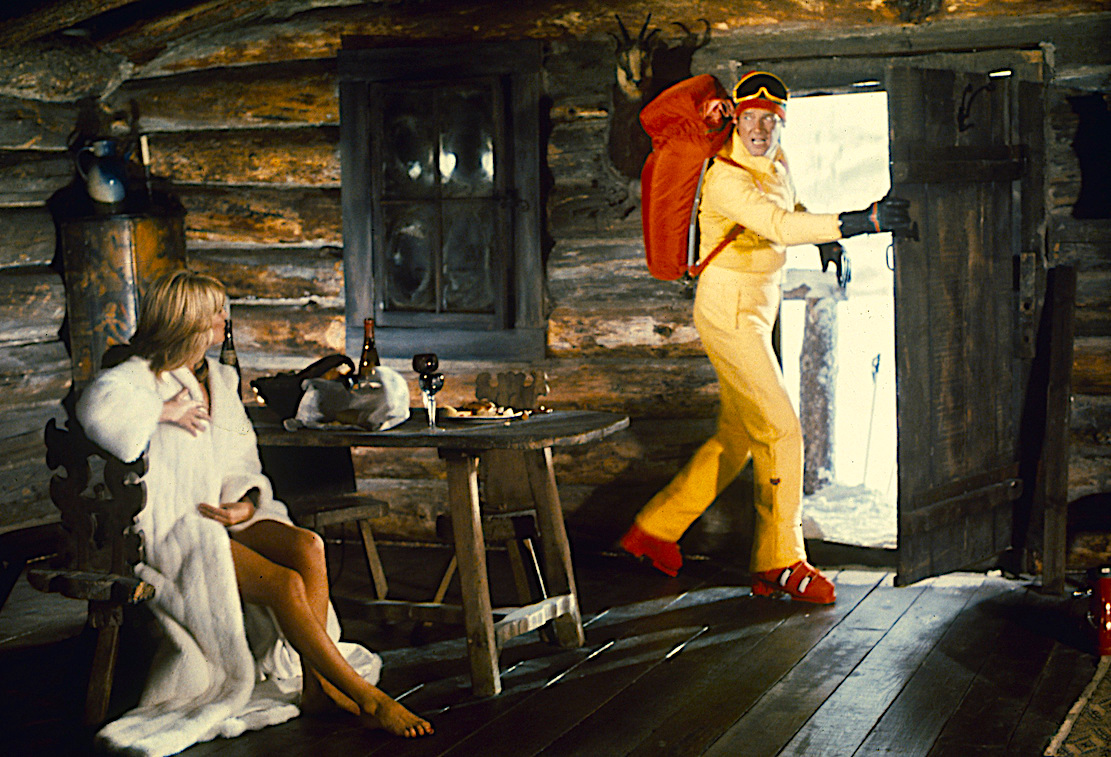 Bond
manages to re-program the
submarines into firing the nukes
at each other, destroying the
subs. He then rescues Anya, kills
Stromburg and drops Jaws into a
shark tank. Anya decides not to
kill Bond, and the Royal Navy
recovers a waterproof pod in which
the two spies are in an intimate
embrace.
Bond
manages to re-program the
submarines into firing the nukes
at each other, destroying the
subs. He then rescues Anya, kills
Stromburg and drops Jaws into a
shark tank. Anya decides not to
kill Bond, and the Royal Navy
recovers a waterproof pod in which
the two spies are in an intimate
embrace.
The film has the most
exotic locales of any in the
series, beginning with Bond’s
skiing away from an overnight
lover, who calls agents to kill
him. The mountain was called
“Berngarten,” but the ski scene
(in which Bond seems to be falling
to his death but is saved by a
Union Jack parachute ) was
actually filmed on the 3,000-foot Asgard
Peak
in Auyuittuq National Park on
the east coast of Nunavut, 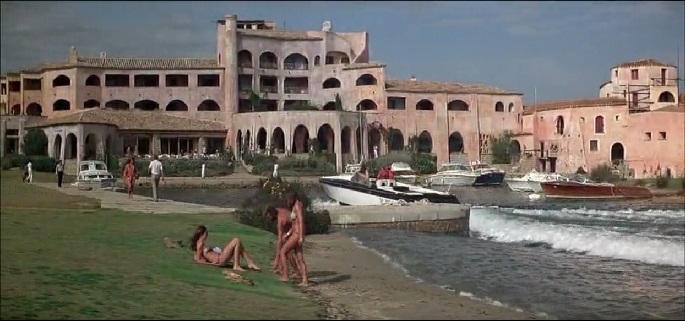 Canada.
Canada.
In Egypt, Bond, dressed in
Bedouin robes and looking like
Lawrence of Arabia, enjoys a meal
of fruit in a tent arrayed with
beautiful women he may choose
among. Later, at Cairo’s Mujaba
Club, Anya sips rum on the rocks
and orders Bond his famous martini
“shaken not stirred.” (So much for
his ever traveling incognito.) She
also uses that description when
Jaws gets crushed between a van
and a wall but survives “shaken
but not stirred.”
Outside of town Bond
attends a spectacular son
et lumière filmed at the Giza
Necropolis complex, about 15 miles
southwest of the
city. (Such shows are 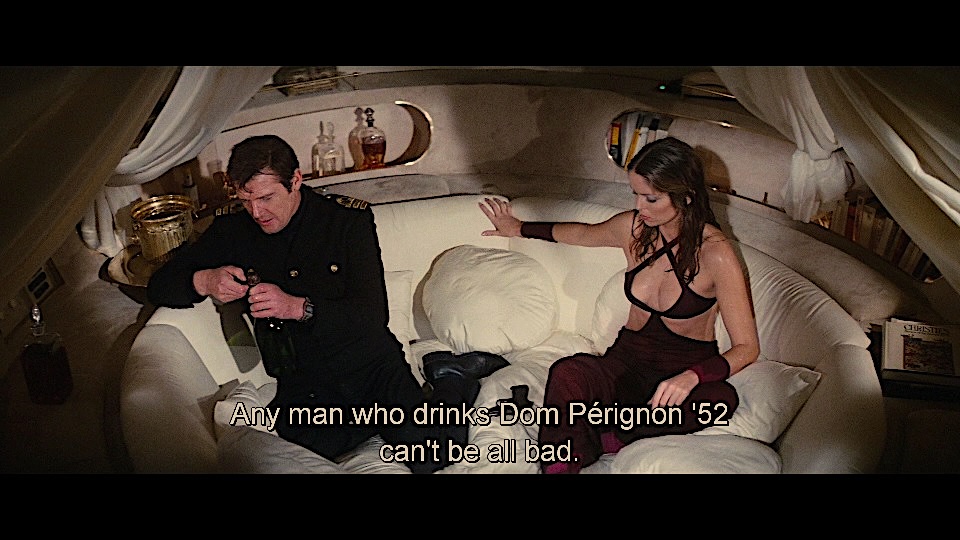 still
presented in that location nightly
for tourists.) After he meets
Anya, they drive to Luxor, on the Nile about 450
miles south of Cairo, and find
Jaws stalking them around the Temple of
Karnak.
still
presented in that location nightly
for tourists.) After he meets
Anya, they drive to Luxor, on the Nile about 450
miles south of Cairo, and find
Jaws stalking them around the Temple of
Karnak.
In Sardinia, on the
island’s jet set side of Costa
Smeralda, Bond checks into the
Hotel Cala di Volpe (above).
The final scenes on the water were
filmed off New Providence Island
at Coral
Harbor, where Thunderball and the
opening scene of Casino
Royale had scenes.
At the movie’s
end, cocooned in their watertight
pod, 007 and Anya sip Dom Pérignon
’52 that Stromburg had stored
there. Bond observes, “Any man who
drinks Dom Pérignon ’52 can’t be
all bad.”
HINOKI
GREENWICH
363 Greenwich Avenue
Greenwich, Connecticut
203-900-0011
By John Mariani
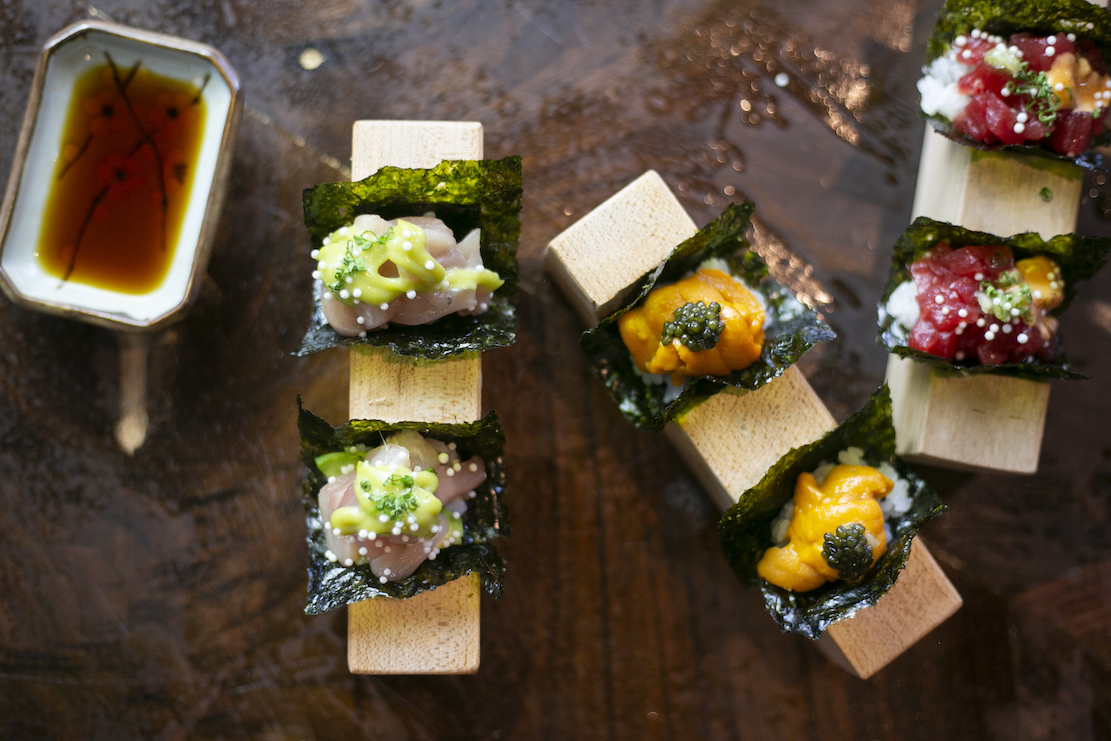
For a relatively small
town—basically, a main street named
Greenwich Avenue—Greenwich, Connecticut, has
a very affluent population. So, all a
restaurateur needs is to find a stylish
niche to fill in order to attract those for
whom caviar, foie gras, wagyu beef and
Champagne are readily affordable.
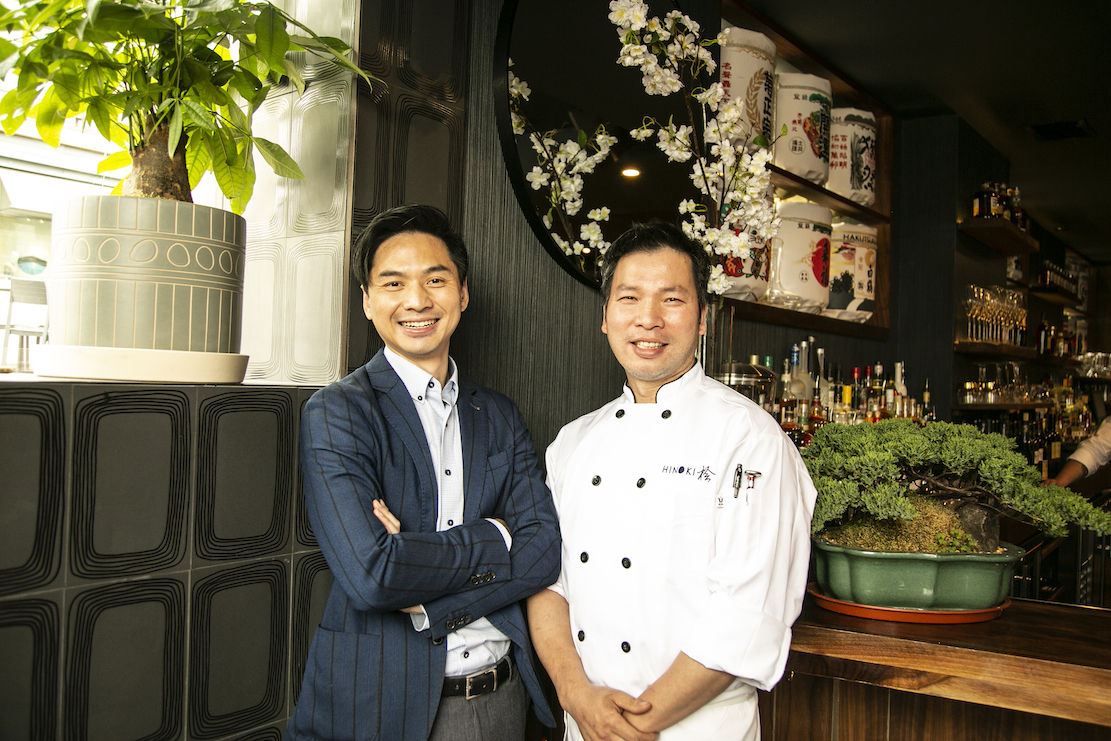 That was
certainly the thinking behind Hinoki
Greenwich, which was opened last May and was
expanded in September by owners K Dong and
chef Stephen Chen, who realized that there was
a place in Greenwich for an expansive Asian
restaurant that went beyond the sushi bars
already dotted around southern Connecticut. (They
already
have three
restaurant concepts together, a wholesale
seafood distribution company, a few
partnerships and plan to expand Hinoki to
Darien next year.)
That was
certainly the thinking behind Hinoki
Greenwich, which was opened last May and was
expanded in September by owners K Dong and
chef Stephen Chen, who realized that there was
a place in Greenwich for an expansive Asian
restaurant that went beyond the sushi bars
already dotted around southern Connecticut. (They
already
have three
restaurant concepts together, a wholesale
seafood distribution company, a few
partnerships and plan to expand Hinoki to
Darien next year.)
The style, they thought, would nod
towards izakaya
meals, in which many small tastes are offered.
But there would also be a section for sushi and
sashimi,
an array of Chinese dim sum
and several larger courses of a kind not
usually available locally. Hinoki Greenwich
compares 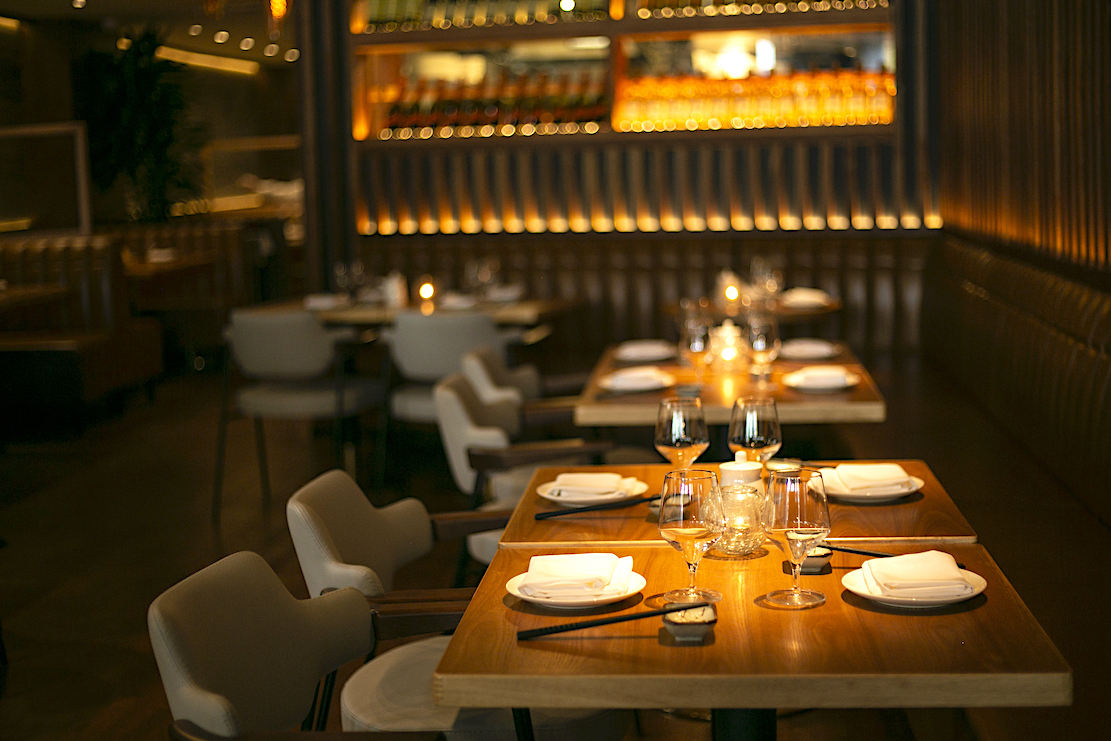 with those
vast, loud Asian nightclubs like Tao, Morimoto
and Buddakan in Manhattan, but without the
madness and party scene those places attract.
with those
vast, loud Asian nightclubs like Tao, Morimoto
and Buddakan in Manhattan, but without the
madness and party scene those places attract.
Hinoki is set in three rooms, one a
bar, another a dining room, and the third,
when it’s up and running, an omakase
dinner room for a chef’s choice menu. The name
Hinoki refers to a wood used throughout that
emits a lovely scent.
What really distinguishes Hinoki is the
quality and sourcing of ingredients. All food
is dependent upon the consistent quality of
product, which huge restaurants needing huge
quantities cannot guarantee. And, when it
comes to raw seafood, there is no margin for
error, which is why most sushi
restaurants’ raw seafood is so often bland. At
Hinoki, the individual flavors of the various
tuna, yellowtail, black cod, king salmon,
fluke and other species are distinct, and
those flavors are enhanced without being
covered up with sauces and spices.
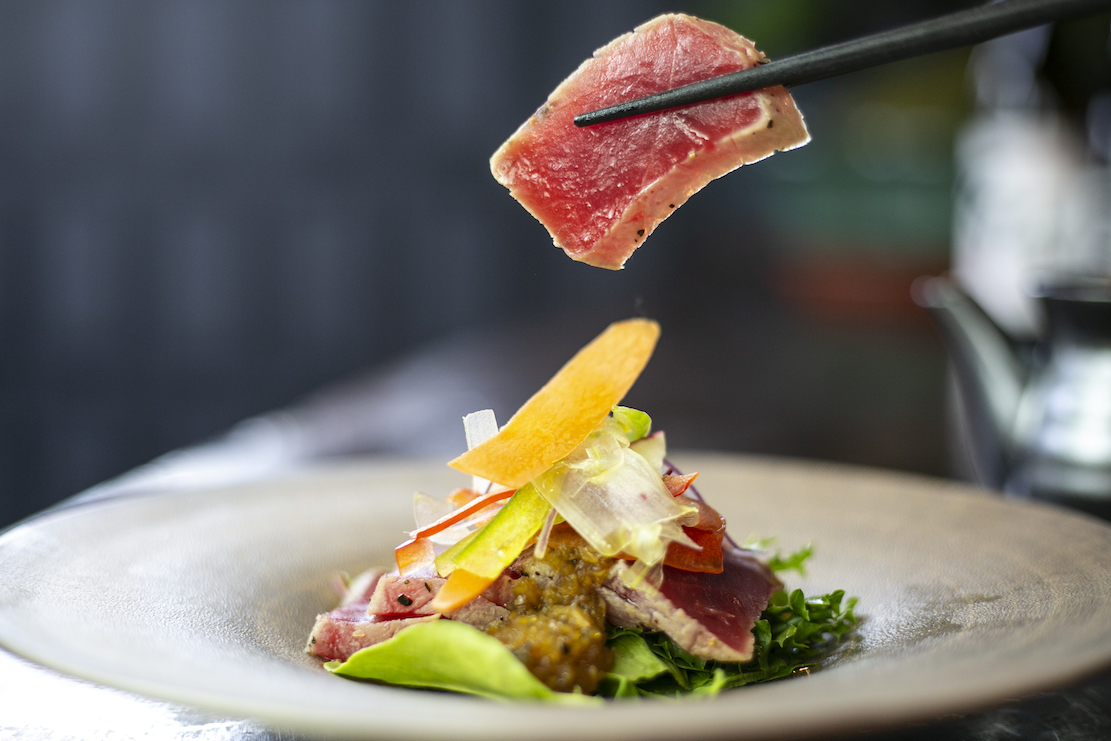 Our
party left choices from every part of the menu
up to Manager Liam Zhang, who first brought a
plate of lustrous baby yellowtail with yuzu
and kosho
chile, a little tomato and, surprisingly,
parmesan cheese ($22). Toro tuna was topped
with truffle oil, olive oil and slices of
Australian black truffles ($28). Thin sliced
salmon mimicked prosciutto set over Asian pear
that looked like melon ($22). Toro
came topped with caviar ($18). A hot appetizer
of duck wrapped pancake ($19) was delicious,
and a “taco” of wagyu beef wrapped in nori
seaweed ($20) was a
Our
party left choices from every part of the menu
up to Manager Liam Zhang, who first brought a
plate of lustrous baby yellowtail with yuzu
and kosho
chile, a little tomato and, surprisingly,
parmesan cheese ($22). Toro tuna was topped
with truffle oil, olive oil and slices of
Australian black truffles ($28). Thin sliced
salmon mimicked prosciutto set over Asian pear
that looked like melon ($22). Toro
came topped with caviar ($18). A hot appetizer
of duck wrapped pancake ($19) was delicious,
and a “taco” of wagyu beef wrapped in nori
seaweed ($20) was a 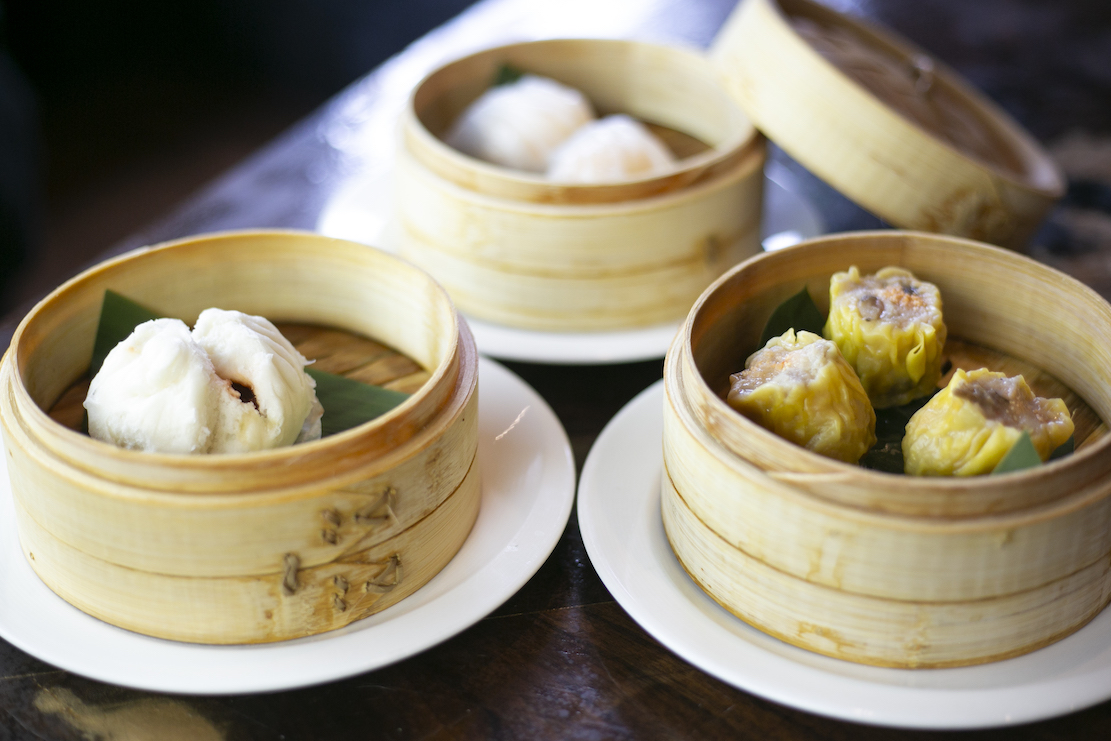 capital
idea with both crunch and juiciness.
capital
idea with both crunch and juiciness.
There are eight dim sum
choices. We had the very flavorful pork soup
dumpling ($16 for four) that bursts in your
mouth with a rich broth, although the noodle
could have been thinner.
All these preambles to the main courses
were light enough to leave us hungry for what
was to follow. Miso black cod, a meaty fish
with a remarkable silkiness, was grilled after
being marinated in miso and served with
grilled endive ($45), one of the best 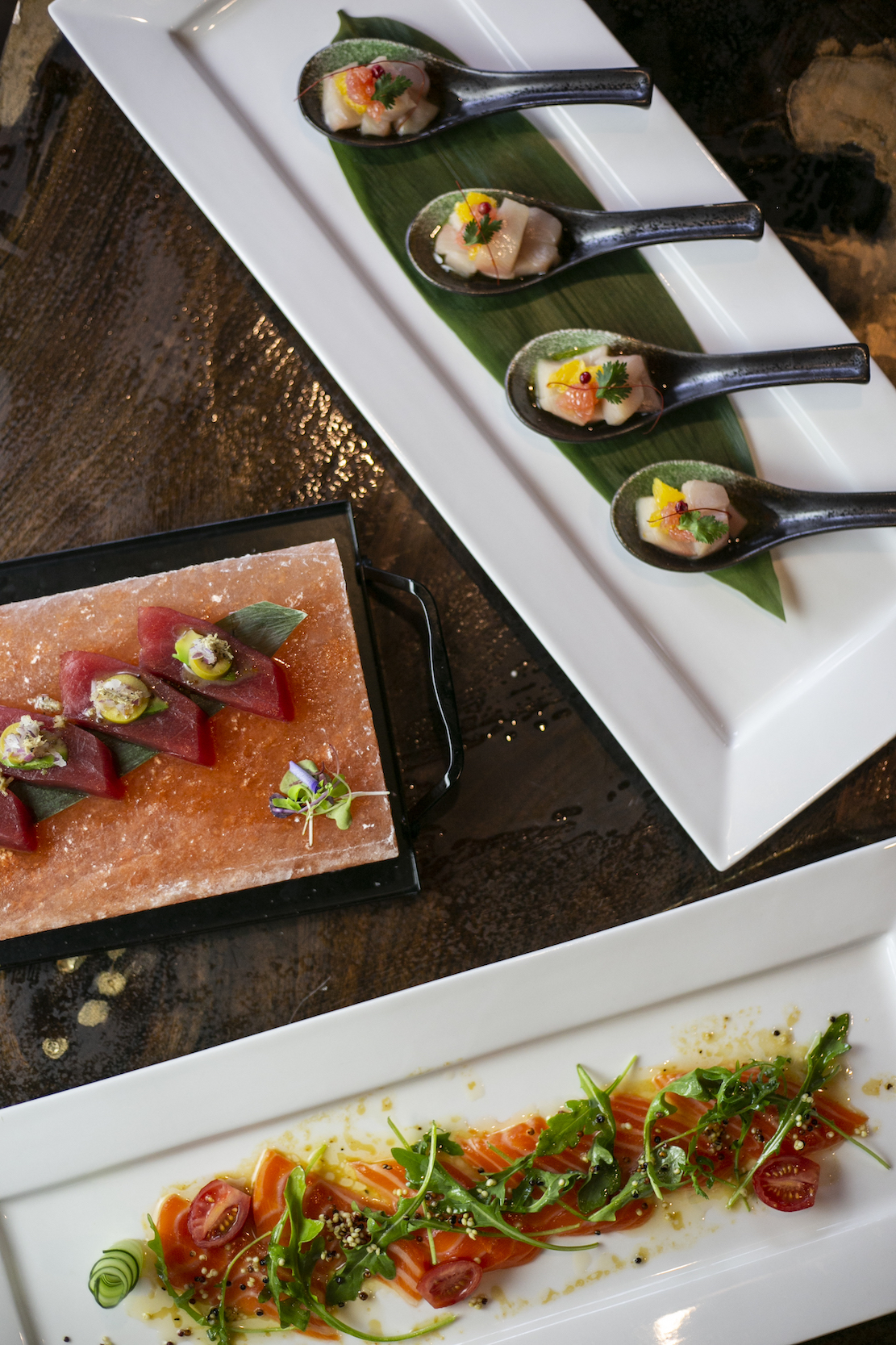 renderings of this
dish I’ve had. A tempura-fried branzino with a
lychee sweet-sour sauce ($38) was pleasant
enough, but I found the King crab truffle hot
pot with wild mushrooms, cheese and truffles
more of a hodgepodge of ingredients mixed
together ($39).
renderings of this
dish I’ve had. A tempura-fried branzino with a
lychee sweet-sour sauce ($38) was pleasant
enough, but I found the King crab truffle hot
pot with wild mushrooms, cheese and truffles
more of a hodgepodge of ingredients mixed
together ($39).
The large bar is a splendid design that
takes its shimmer from the bottles of spirits
arrayed, and there are some very rare items up
there, especially among the Japanese whiskies.
The wine list, however, is modest.
On a laid-back Monday the attractive
waitstaff played their part by spending much
of their time at the bar on their cell phones.
Also, depending on the music playing, you’ll
hear either a pounding bass line or some
pleasing sounds of jazz.
Hinoki
Greenwich is a refined and quite
serious Asian restaurant focused on quality,
so that you may well find many of the dishes
on others’ menus, but the flavors have more
spark to them at Hinok, while Chef Chen’s
innovations make it all the more reason to
go.
Open for
lunch and dinner seven days a week.
❖❖❖
ANOTHER
VERMEER

By John Mariani
CHAPTER FORTY-SEVEN
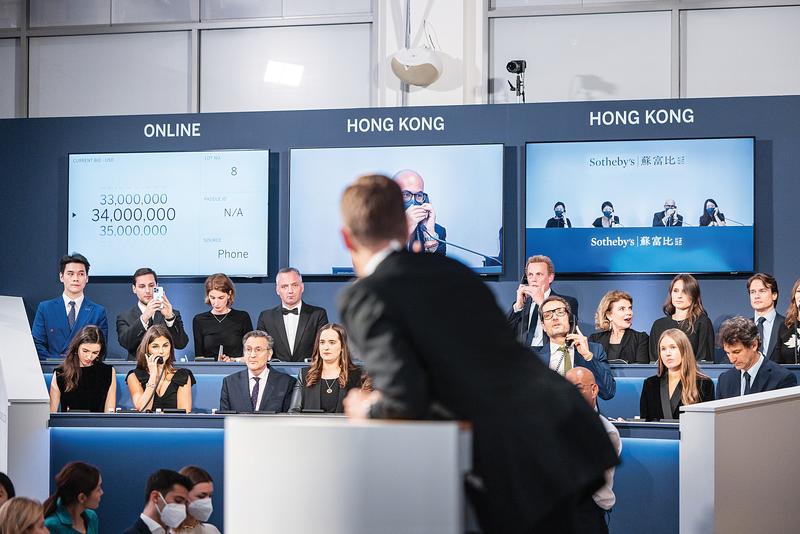
Katie and David thanked the Currens for
all their help and hospitality, and Mrs. Curren
said it had been their pleasure. “We don’t
really get to see that many Americans here,” she
said. “More
Brits than Yanks. Oh, and, David, your new suit
was delivered this morning.”
David wasn’t about to model the new dark
gray suit, but he knew this was by far the
best-fitting suit he’d ever put on. Nothing like
the off-the-rack suits he bought at Men’s
Warehouse on sale that took a beating while he was
on the force. Since retiring, he’d only really
worn a jacket when he was out to dinner with
Katie, and he really was looking forward to
showing himself off in his new threads at the
auction the next day.
That morning, after breakfast, David came
out of his room wearing the suit, trying not to
smile too much.
“My God, David,” said Katie, who was
dressed in a smart shirt-waist blue dress. “You
look fabulous in that suit! Fits you like a
glove.”
David tried to shrug off the compliment,
but he’d never felt better about getting one from
a woman like Katie Cavuto.
Hong Kong’s art galleries and auction
houses were all located in the central part of the
city. Christie’s was on Chater Road, Sotheby’s on
Pacific Place and Crofthouse around the corner on
Star Street. Despite its longevity as an auction
house in Hong Kong, Crofthouse was fairly modest
in size, its offices on the first floor, the
galleries on the second.
The
brochure description of the Vermeer was very
carefully worded and, given British reserve, not
extravagant. It noted the probable date of the
painting, its similarities to The
Astronomer and The
Geographer, and the possibility that it had
been part of a triptych. It did not say how the
painting got to China, or when, only that it was
owned by the People’s Republic of China. Lastly, a
statement of authenticity was made, based on the
150-page experts’ report.
A daytime auction was held, as ever, for
fairly inexpensive or lesser works, while the
evening auction, to begin at 7 o’clock, was
reserved for the best lots of the event, ending
off with the sale of the Vermeer.
Numbered bidding paddles had been handed
out, V.I.P. seats assigned and the room started to
fill up by 6:30. Cameras were not allowed, but
there was an unusual number of journalist, from
the art magazines and the regular Hong Kong,
Chinese and international news organizations, who
had come to see if this would indeed be the
highest price ever paid for a painting.
Katie and David had been there since three
o’clock, anxious to get a quick education on how
auctions were held, observing the ballet that goes
on between auctioneer, his assistants and bidders
in the audience. Clearly, there were bidders who
did not use a paddle but, long known to the
auction house, used personal signals—a finger on
the left cheek, a pen in the breast pocket, legs
crossed or uncrossed—that indicated they were, or
were not, still in the bidding. In the daytime
auctions phone bids were a rarity, but at night
they became a major aspect of the bidding.
Katie knew a few of the journalists in the
room, but David knew no one, feeling like the odd
man out, but he was enjoying being with Katie on a
day when he had no investigating to do. After the
auction, he hoped to take her out to dinner, then
fly home the next day.
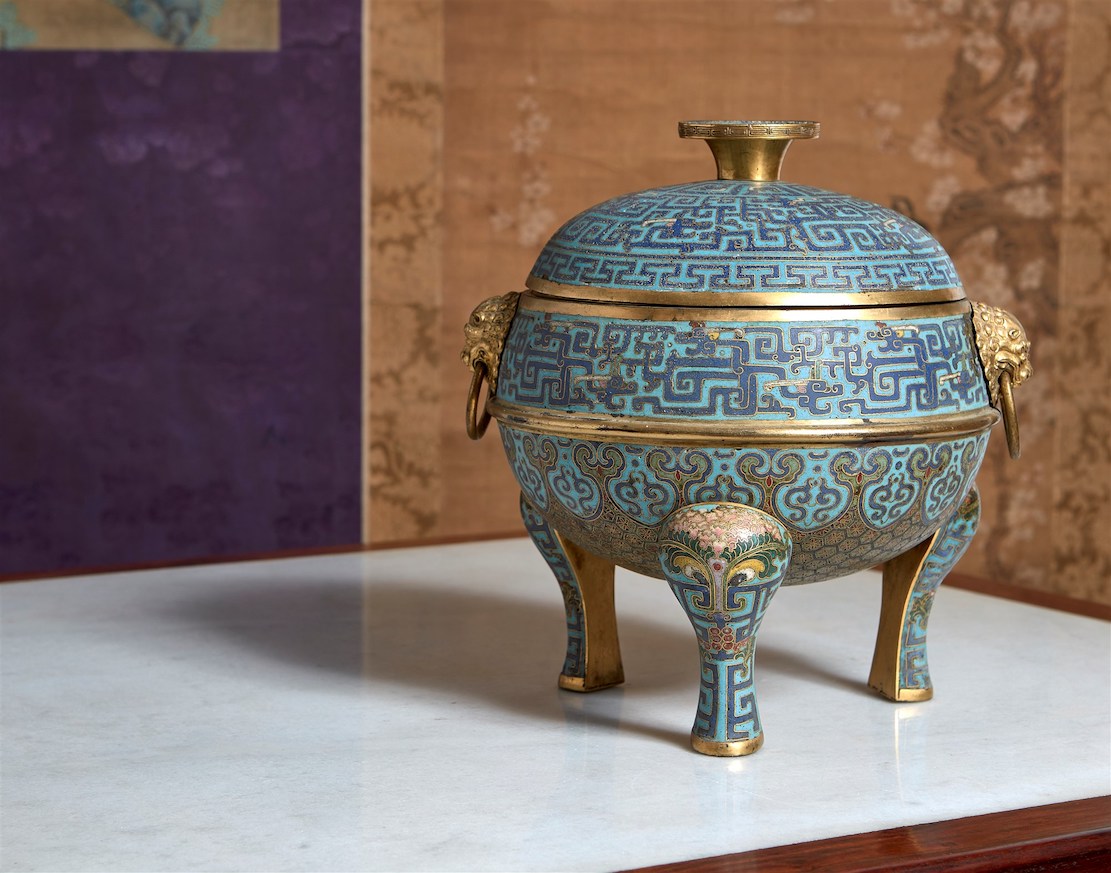 The
make-up of the evening audience was fairly well
split between Asians and Westerners, with what
seemed to be small coteries of acquaintances from
the art world, all gossiping about the Vermeer and
what it would sell for. The journalists, including
Katie, were asking them questions, getting
statements, hoping someone would say something
provocative. Many of the Asians came in together,
after having their last cigarettes outside.
The
make-up of the evening audience was fairly well
split between Asians and Westerners, with what
seemed to be small coteries of acquaintances from
the art world, all gossiping about the Vermeer and
what it would sell for. The journalists, including
Katie, were asking them questions, getting
statements, hoping someone would say something
provocative. Many of the Asians came in together,
after having their last cigarettes outside.
The auctioneer was a man who looked quite
young for the job. Derrick Donaldson was standing
off to his side, cupping his hand over a phone,
with another two assistants doing the same. The
auctioneer introduced himself, asked everyone to
be seated, and, without further ado, said, “Lot
223, a Chinese porcelain figure from the late Ming
Dynasty, a very beautiful piece from the
collection of Mr. Edwin Taylor of Hong Kong. Shall
we start the bidding at $15,000?”
For lots expected to sell for under
$100,000 the auctioneer’s first figure was
intended to send a signal as to how high the
increments would be, usually $5,000 to $10,000; if
above $100,000, bidding might go up by $20,000 or
more, if there was plenty of interest in the
piece. If bidding was slow, or none at all, the
auctioneer might make a “chandelier bid” of his
own, pretending someone in the audience or on the
phone had taken the last bid; if the ploy didn’t
work, the auctioneer would snap, “Pass,” and move
immediately to the next lot.
As the evening wore on, with 36 lots to be
sold, the artwork became finer and finer. Aside
from the Vermeer, there were only two pieces of
Western art—a Victorian night table and a small
18th century Italian landscape, both from Hong
Kong sellers. Bids were all over the price range,
with the best Chinese works doing quite well,
others garnering low bids. But as of 8:30, the
excitement over the upcoming Vermeer was palpable,
people whispering, looking over at the box seats
as at the opera, where bidders who did not wish to
be known rustled the curtains drawn in front of
them.
“And now, ladies and gentlemen,” said the
auctioneer, “our last lot of the evening, and one
that I can see is causing a great deal of
excitement in the art world.” Draperies parted
behind the auctioneer and two assistants carried
the painting out and placed it on an easel.
There were audible gasps from the audience,
not only because they were seeing a long-lost
masterpiece for the first time but because it
looked so small—a mere twenty by eighteen inches,
the same as The
Astronomer and The
Geographer—in a remarkably simple gilded
frame. On
size alone, it didn’t look like a $100 million
painting. 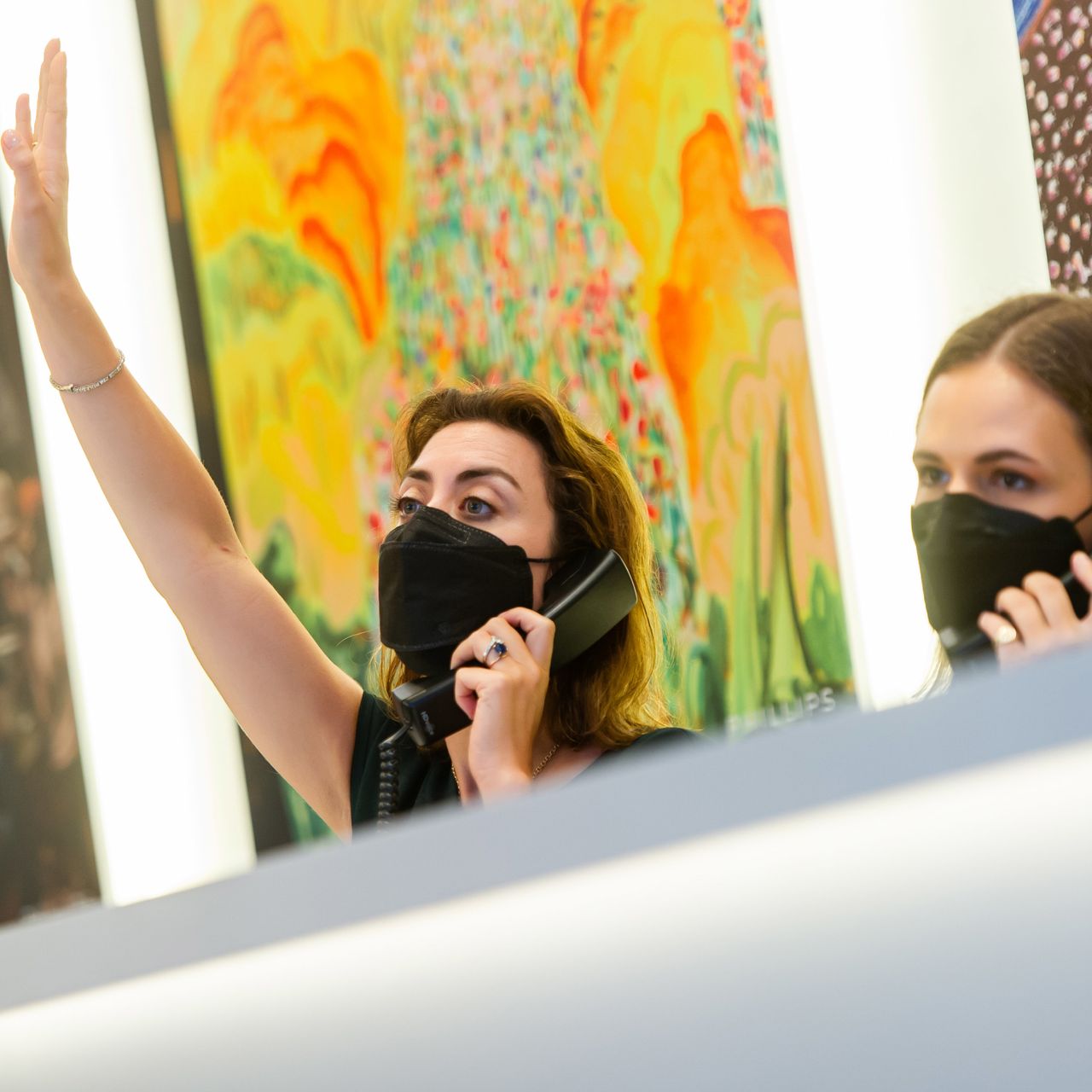
The auctioneer made brief remarks about the
painting without extravagant praise, and said,
nonchalantly, “Shall we begin at $50 million?”
One paddle was raised. The auctioneer went
up by $2 million, got a bid, then $5 million,
another bid. Things were going well, and all the
bidding was coming from the floor, beginning with
five paddles, then four, three, two by the time
the bid was $75 million.
“Do I hear $80 million?” The floor bids
stopped, but immediately the auctioneer was being
signaled by Derrick Donaldson that a caller had
come into the action.
“Eighty-five million?”
Another nod, this time from the assistant
on another phone.
“Ninety million?” said the auctioneer.
There was a pause.
The auctioneer looked over at his
colleagues. Nothing.
“Shall we say eighty-seven?”
A nod came.
“Eighty-nine?”
Yes, from Donaldson.
“Ninety? Ninety million dollars?”
Another pause, this one longer. It would be
unseemly for the auctioneer to suggest
eighty-nine-five, but he could clearly tell the
other phone bidder needed to be coaxed.
“We are at eighty-nine million for a unique
painting of a kind that we may never see the likes
of again. No one has bought an authenticated Jan
Vermeer in more than a hundred years. Once this is
gone, there may never be another chance. Will
anyone go to ninety?”
He gazed out over
the audience, which had grown completely silent.
There was no rustling of the box seat curtains.
“We have a bid for eighty-nine million
dollars. Going once. Going twice.” He had
the hammer raised. Then Donaldson waved his hand.
“Ninety!” said the auctioneer triumphantly.
“The bid is at ninety million dollars. Will anyone
go to ninety-five?”
Katie looked at David, wide-eyed.
“Ninety-five,” said the auctioneer, slowly,
sensing the momentum had run its course. “It’s now
ninety million dollars . . . going once . . .”—he
looked at Donaldson and his assistants, all subtly
wagging their heads.
“Last chance. Ninety million dollars . . .
going twice . . .”
Then he slammed the
hammer down.
 “Sold
for ninety-million dollars! Congratulations to the
buyer, who has just paid the most money for any
work of art in history. And
Crofthouse is honored to have been the auction
house of record. Thank you, ladies and gentlemen,
that ends tonight’s very exciting auction.”
“Sold
for ninety-million dollars! Congratulations to the
buyer, who has just paid the most money for any
work of art in history. And
Crofthouse is honored to have been the auction
house of record. Thank you, ladies and gentlemen,
that ends tonight’s very exciting auction.”
Katie said, “Wow, ten million shy of what
everyone thought it would go for. I wonder
what happened.”
“Don’t ask me,” said David. “You’d better
schmooze with your colleagues and the other
bidders here, see if you can find out.”
Katie, along with other journalists
present, had already surrounded the five bidders
in the audience, who had gathered themselves into
a discussion of what had just occurred. Katie
identified herself and asked the bidders who they
were or for whom they were bidding.
Two
said they were bidding for anonymous collectors.
One was from the Getty Museum in Los Angeles, one
from the Norton Simon Museum in Pasadena, and one
from New York’s Metropolitan Museum of Art, whose
floor bidder was the last to drop out, at $75
million.
Each
was asked if, given their museums’ resources, they
thought they had a real chance of getting the
painting. The people from the Simon and Met
museums said they were not authorized to go beyond
their final bids.
The man from the Getty said, “We might have
gone higher, but you have to be able to judge
where something might end up, and as an
institution, we can’t get into a feeding frenzy.
We felt that the tempo of the bidding indicated
the painting would go much higher.”
“Would you have paid $95 million?” asked
Katie. The man just turned up his hands and said,
“I really can’t comment on that.”
Katie then
went over to Derrick Donaldson, who was in
conference with his auctioneer and several
Chinese, who were there representing their
country’s sale. Donaldson was speaking to them in
perfect Mandarin, obviously trying to explain why
the final bid was so much lower than everyone had
expected. When they’d finished talking, the
Chinese stalked away, still gesturing, and Katie
moved towards Donaldson and asked if they could
speak.
“May I ask you a couple of questions?”
“Sure,” said Donaldson, seeming a little
shell-shocked. “But I can’t tell you who the buyer
is. Both the callers wish to remain anonymous at
this point.”
“Okay, but why do you think the final price
was so much lower than expected?”
Donaldson sighed and said, “Quite simply,
not enough bidders.
We’d anticipated that there were not going
to be any museums able to bid $100 million, and
they must have believed the phone bids would just
keeping going up and up. The two individuals in
the audience who were bidding I do know. One is a
French collector named Branaire, the other
Mexican, name of Santiago. I suppose it just got
too rich even for their bank accounts.”
“I take it Shui didn’t bid,” said Katie.
“Never heard from him.”
“What about Jan Dorenbosch, Nicholas
Danielides, Ivan Stepanossky, Robert Lauden, or
Harry Balaton?”
“I really can’t say, because I don’t know
the answer right now. I can
say we had some preliminary interest from Mr.
Steve Wynn, but he never ended up bidding.”
“And the guys in the box seats behind the
curtain?”
“Never made their move.”
© John Mariani, 2016
❖❖❖
THE WINES OF PUGLIA
By John Mariani
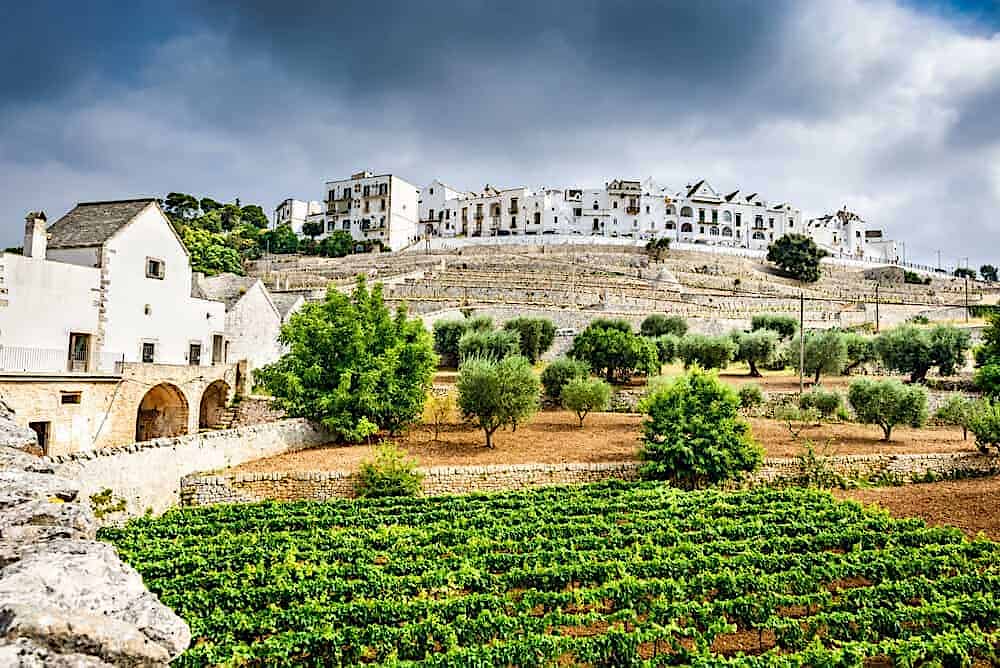
Vineyards in Locorotondo, Puglia
Like Puglia itself—the heel of Italy—its
wine industry has gained both interest and respect
just in the last five years. In the past, large
numbers of cooperatives sold their wines in bulk,
but a younger generation has winnowed down the
best varietals and terroirs to produce excellent
wines that now compete, usually at a more modest
price, in the global market.
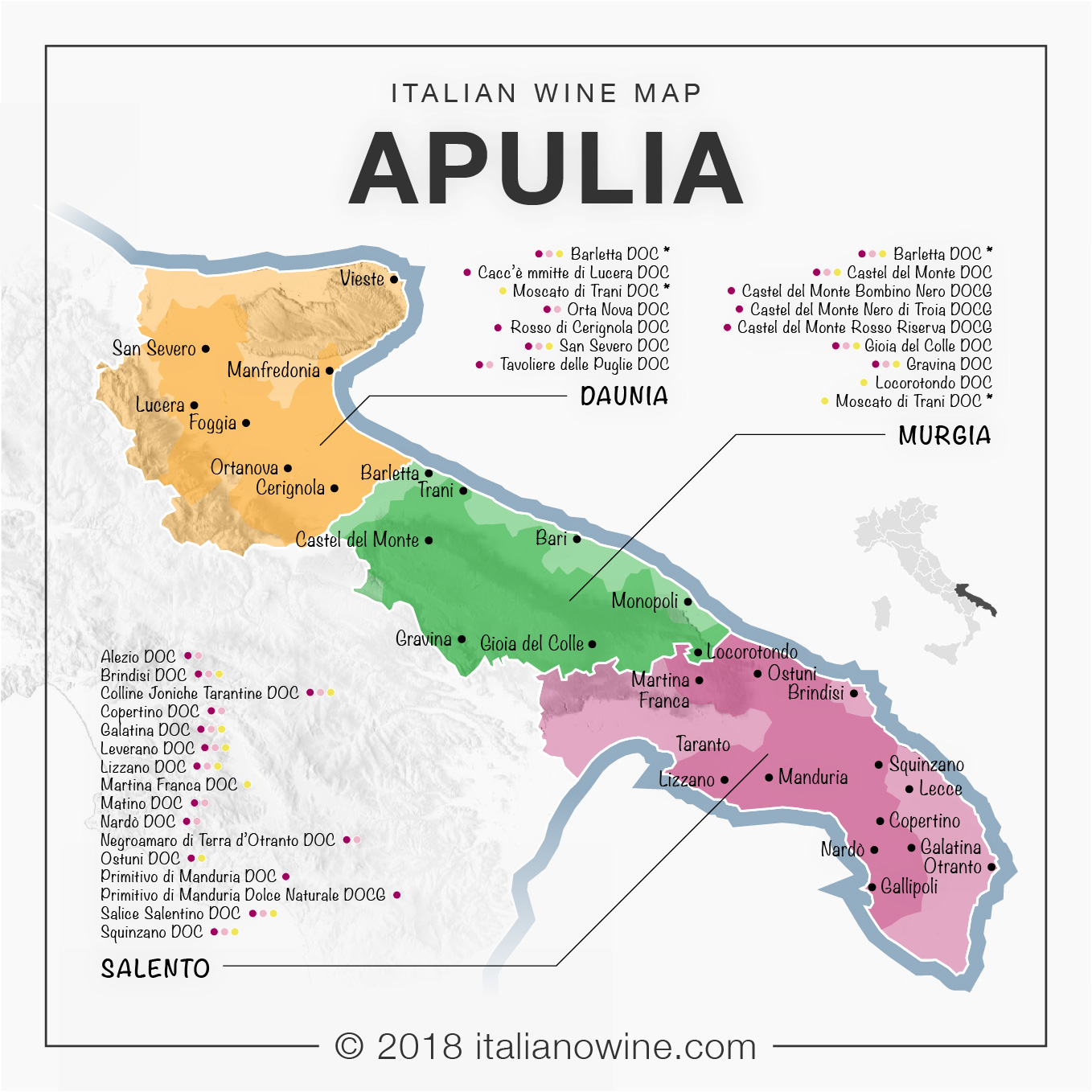 Today
Puglia produces 32 wines in the DOC appellation and
four DOCGs, with new IGP wines coming out all the
time. The
manifest success of Puglian wines is clear in its
bottling and export figures. While southern Italy
exports only 6% of its production, 90% of Puglia’s
bottled wine production is sold outside Italy. Plus, Puglia is
now the second largest Italian producer of organic
wines, after Sicily.
Today
Puglia produces 32 wines in the DOC appellation and
four DOCGs, with new IGP wines coming out all the
time. The
manifest success of Puglian wines is clear in its
bottling and export figures. While southern Italy
exports only 6% of its production, 90% of Puglia’s
bottled wine production is sold outside Italy. Plus, Puglia is
now the second largest Italian producer of organic
wines, after Sicily.
Varietals like Negroamaro, Bombino Bianco,
Gravina and Primitivo, once unfamiliar even within
Italy, are now celebrated for their distinctiveness.
Primitivo, once unfamiliar even within Italy, are
now celebrated for their distinctiveness. Primitivo
got a boost when it was found to be a forerunner of
what in the U.S. is called Zinfandel. 
Agro-tourism has also been a boon to both the
region and the industry. Murgia, with many Adriatic
microclimates, has proven itself fertile ground for
Primitivo, as well as the Nero di Troia grape, as
the basis for Castel del Monte DOC wines like Rosso
Canosa and Rosso di Barletta, while fragrant white
varietals like Malvasia del Chianti, Greco and
Bianco d’Alessano go into Gravina.
The so-called “Itria Valley Triangle” that
embraces the provinces
of Bari, Brindisi and Taranto produces Martina and
Locorotondo, made principally from white Verdeca and
Bianco d’Alessano grapes. Outside
the “white city” of Ostuni, two indigenous grape
varieties, Ottavianello and Susumaniello, are now
being made in artisanal style and achieving a unique
renown of their own.
Much of the excitement in Puglian vineyards
is due to the appellation IGP (Indicazione
Geographica Produzione), which allows
producers to work with blends outside the DOC rules. A leading
innovator is Gaetano Marangelli (above) of
Cantine Menhir Salento in the southeastern part of
Salento, who is dedicated to inclusiveness of
viniculture and agro-tourism. “Fifty years ago all
the wineries also produced their own olive oil,
cheese, even chickens and eggs,” he says. “I and
some of my colleagues are trying to re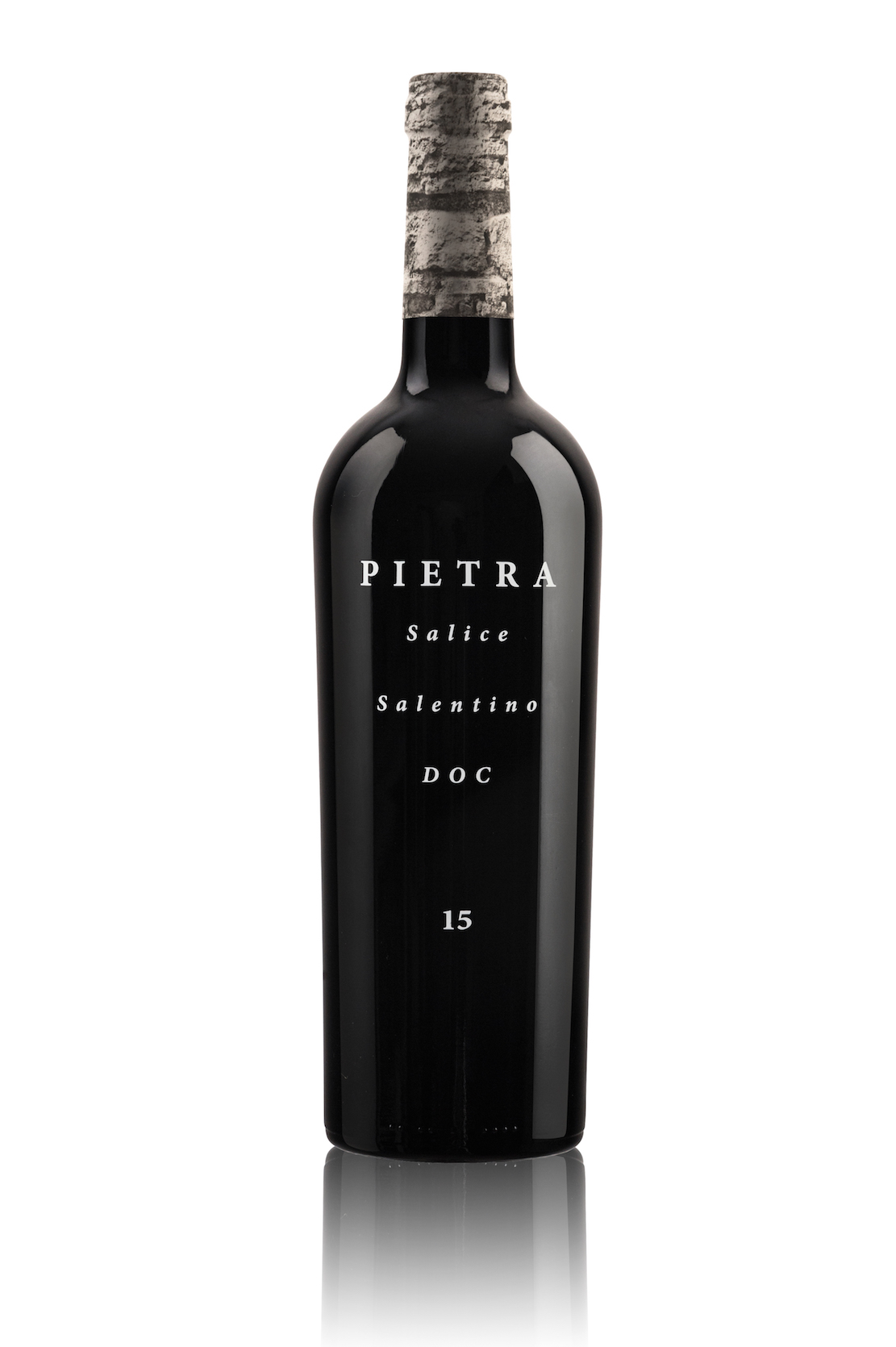 store that.”
store that.”
To such end his property is home
to a 40-hectare organic farm named “Anna” that
supplies many of the provisions to the on-premises
Origano Osteria & Store, which also has a small
restaurant, and he is building a 30-room hotel. His
flagship wine, with only 15,000 bottles produced
annually, is the Pietra Primitivo Susumaniello,
which I would rank with many of the finest red wines
in Italy. If there were such a class as “Super
Puglians,” this would be one of them.
While recently in Puglia I also visited the
Vallone estate, dating to the second half of the
19th century, when Commendatore Vincenzo De Marco
began the production and marketing of bulk wines to
France and Tuscany.
The marriage of Donato Vallone to Marco’s
daughter Maria brought in the Flaminio Estate of
Brindisi to the family, and later, at the end of the
‘60s, the Castel
Serranova estate was added, now totaling 500
hectares. 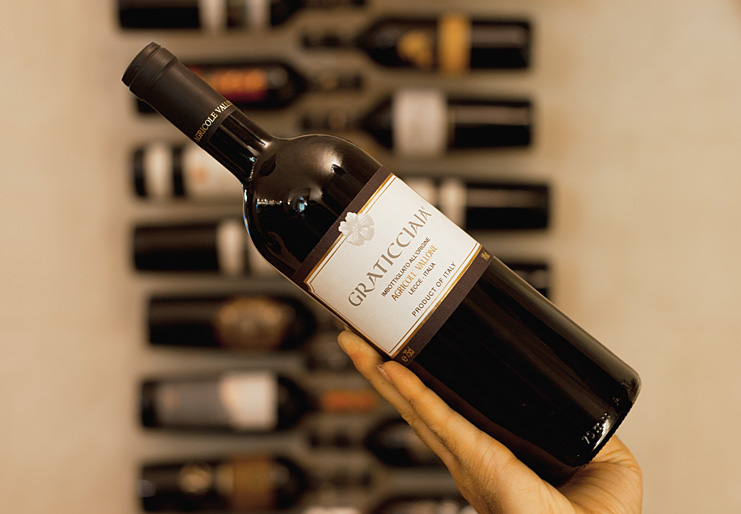
Over a buffet lunch at Vallone’s estate (below),
my wife and I sampled wines obviously made by
oenologist Severino Garofano according to all modern
technologies. Balanced and distinctive as local
varieties, they went splendidly with Puglian
cheeses, meats and pastas presented.
I was very impressed by the Graticciata Rosso
IGP Salento, using
dried Negroamaro grapes from the 'Caragnuli'
Cru, an 80-year-old Apulian sapling vineyard in San
Pancrazio Salento.
After six years of experimenting, the wine
has emerged as a voluptuous and strikingly big wine
at 14.5% alcohol.
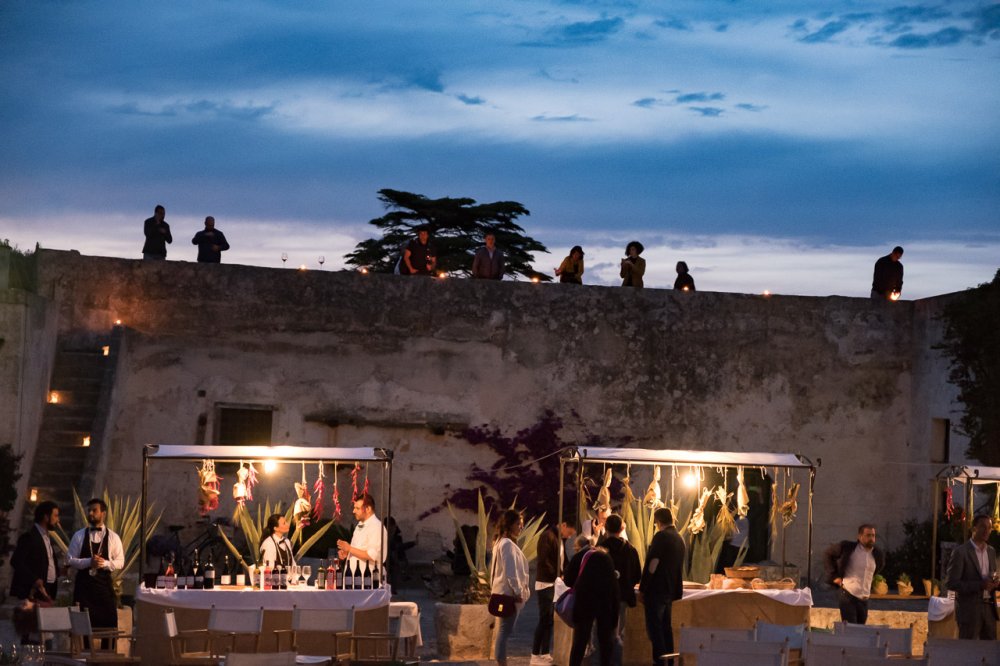 Castel
Serranova is a Cru from a vineyard called Vigna
Castello, the origin of the most classic of the
Salento blends, namely Negroamaro and Susumaniello. Vallone
makes both a red and a lovely rosé from the
Susumaniello, using the traditional static draining
technique to give complexity. Flaminia, from an
estate near Ostuni, is another line of the Vallone
wines using the grape Ottavianello, with a wonderful
perfume, similar to France’s Cinsault.
Castel
Serranova is a Cru from a vineyard called Vigna
Castello, the origin of the most classic of the
Salento blends, namely Negroamaro and Susumaniello. Vallone
makes both a red and a lovely rosé from the
Susumaniello, using the traditional static draining
technique to give complexity. Flaminia, from an
estate near Ostuni, is another line of the Vallone
wines using the grape Ottavianello, with a wonderful
perfume, similar to France’s Cinsault.
Vallone is dedicated to the balance of nature
within the vineyards, including the reduction of
unwanted invasive insects. “We used a spray that
confuses the males sexually, so they don’t mate,”
Francesco Vallone told me, “and out of fear our
workers put on masks and gloves so the same would
not happen to them.”
These innovations caused Vallone to diverge
from the strict DOC regulations. “We want to be IGP,
because we want to do what we want. We don’t want to
be judged under DOC bureaucratic standards.”
Of particular note is a new emphasis on rosé
(rosato)
wines in Puglia. Given the wide variety of red
grapes in the region,
innovative winemakers have picked up on the current
fashion for rosé as a year-round wine, not one just
for summer months. Since Puglia’s rosés differ so
widely, from pale pink to deep rose, there are
different levels of complexity and intensity, so
that they go especially well with the bounty of
seafood that is the mainstay of the region’s
gastronomy.
in the region,
innovative winemakers have picked up on the current
fashion for rosé as a year-round wine, not one just
for summer months. Since Puglia’s rosés differ so
widely, from pale pink to deep rose, there are
different levels of complexity and intensity, so
that they go especially well with the bounty of
seafood that is the mainstay of the region’s
gastronomy.
Rosés made
from Nero di Troia are particularly rich—they are
called the ”black rosés of Troy.” As with many
“lost” varietals, Bombino Nero was rediscovered in
Puglia and is one of the principal grapes used for
rosés, acquiring a prestigious DOCG appellation for
Bombino Nero Rosato Castel del Monte.
Tuccanese is also a re-discovered grape,
thought to be a clone of
the hearty Sangiovese.
Aleatico,
of Greek origins, is considered a
semi-aromatic grape variety, derived from Moscato,
and having a wonderful perfume. It is grown for DOC
wine in the areas of Bari, Brindisi, Taranto, Lecce
and Foggia. The Primitivo, whose resurrection as a versatile
grape has led to innovations, produces a bold,
deeply colored rosé with plenty of spice.
Ottavianello has also had a resurgence in the
current century, especially around Brindisi, often
made in a light, pale style with good
aromatics.
As recently as 2015
the authoritative
Oxford
Companion to Wine warned
that, “what Puglia urgently needs is to
ensure the survival of its centenarian bush vines
and most interesting indigenous varieties, and,
ideally, a viticultural in winemaking institute . .
. to shape its future.” That future has arrived far
more quickly than anyone could have imagined.

INJURED IN THE INCIDENT
“Yesterday, we had a customer come in and order takeout, a barbecue plate and a couple sides,” said Ashley Holt, whose mother, Debbie Holt, owns Clyde Cooper’s Barbecue in Raleigh and interacted with the customer. “She left and came back and said her barbecue was undercooked because it had a lot of pink in it. We explained that’s because it’s smoked. When pork is smoked, it turns pink.” Holt said a few minutes later a Raleigh Police officer came to the restaurant, talked to the customer outside and then entered Clyde Cooper’s, asking about the pork.
❖❖❖
Any of John Mariani's books below may be ordered from amazon.com.
 The Hound in Heaven
(21st Century Lion Books) is a novella, and
for anyone who loves dogs, Christmas, romance,
inspiration, even the supernatural, I hope you'll find
this to be a treasured favorite. The story
concerns how, after a New England teacher, his wife and
their two daughters adopt a stray puppy found in their
barn in northern Maine, their lives seem full of promise.
But when tragedy strikes, their wonderful dog Lazarus and
the spirit of Christmas are the only things that may bring
his master back from the edge of despair.
The Hound in Heaven
(21st Century Lion Books) is a novella, and
for anyone who loves dogs, Christmas, romance,
inspiration, even the supernatural, I hope you'll find
this to be a treasured favorite. The story
concerns how, after a New England teacher, his wife and
their two daughters adopt a stray puppy found in their
barn in northern Maine, their lives seem full of promise.
But when tragedy strikes, their wonderful dog Lazarus and
the spirit of Christmas are the only things that may bring
his master back from the edge of despair. WATCH THE VIDEO!
“What a huge surprise turn this story took! I was completely stunned! I truly enjoyed this book and its message.” – Actress Ali MacGraw
“He had me at Page One. The amount of heart, human insight, soul searching, and deft literary strength that John Mariani pours into this airtight novella is vertigo-inducing. Perhaps ‘wow’ would be the best comment.” – James Dalessandro, author of Bohemian Heart and 1906.
“John Mariani’s Hound in Heaven starts with a well-painted portrayal of an American family, along with the requisite dog. A surprise event flips the action of the novel and captures us for a voyage leading to a hopeful and heart-warming message. A page turning, one sitting read, it’s the perfect antidote for the winter and promotion of holiday celebration.” – Ann Pearlman, author of The Christmas Cookie Club and A Gift for my Sister.
“John Mariani’s concise, achingly beautiful novella pulls a literary rabbit out of a hat – a mash-up of the cosmic and the intimate, the tragic and the heart-warming – a Christmas tale for all ages, and all faiths. Read it to your children, read it to yourself… but read it. Early and often. Highly recommended.” – Jay Bonansinga, New York Times bestselling author of Pinkerton’s War, The Sinking of The Eastland, and The Walking Dead: The Road To Woodbury.
“Amazing things happen when you open your heart to an animal. The Hound in Heaven delivers a powerful story of healing that is forged in the spiritual relationship between a man and his best friend. The book brings a message of hope that can enrich our images of family, love, and loss.” – Dr. Barbara Royal, author of The Royal Treatment.
 |
The Encyclopedia of American Food and Drink by John F. Mariani (Bloomsbury USA, $35) Modesty forbids me to praise my own new book, but let me proudly say that it is an extensive revision of the 4th edition that appeared more than a decade ago, before locavores, molecular cuisine, modernist cuisine, the Food Network and so much more, now included. Word origins have been completely updated, as have per capita consumption and production stats. Most important, for the first time since publication in the 1980s, the book includes more than 100 biographies of Americans who have changed the way we cook, eat and drink -- from Fannie Farmer and Julia Child to Robert Mondavi and Thomas Keller. "This book is amazing! It has entries for everything from `abalone' to `zwieback,' plus more than 500 recipes for classic American dishes and drinks."--Devra First, The Boston Globe. "Much needed in any kitchen library."--Bon Appetit. |
"Eating Italian will never be the same after reading John Mariani's entertaining and savory gastronomical history of the cuisine of Italy and how it won over appetites worldwide. . . . This book is such a tasteful narrative that it will literally make you hungry for Italian food and arouse your appetite for gastronomical history."--Don Oldenburg, USA Today. "Italian
restaurants--some good, some glitzy--far
outnumber their French rivals. Many of
these establishments are zestfully described
in How Italian Food Conquered the World, an
entertaining and fact-filled chronicle by
food-and-wine correspondent John F.
Mariani."--Aram Bakshian Jr., Wall Street
Journal.
"Equal parts
history, sociology, gastronomy, and just
plain fun, How Italian Food Conquered the
World tells the captivating and delicious
story of the (let's face it) everybody's
favorite cuisine with clarity, verve and
more than one surprise."--Colman Andrews,
editorial director of The Daily
Meal.com. "A fantastic and fascinating
read, covering everything from the influence
of Venice's spice trade to the impact of
Italian immigrants in America and the
evolution of alta cucina. This book will
serve as a terrific resource to anyone
interested in the real story of Italian
food."--Mary Ann Esposito, host of PBS-TV's
Ciao
Italia. "John Mariani has written the
definitive history of how Italians won their
way into our hearts, minds, and
stomachs. It's a story of pleasure over
pomp and taste over technique."--Danny Meyer,
owner of NYC restaurants Union Square
Cafe, The Modern, and Maialino.
|
 |
 |
 |
 |
 |
 |
 Everett Potter's Travel Report:
Everett Potter's Travel Report: 
 Eating Las
Vegas
Eating Las
Vegas
MARIANI'S VIRTUAL GOURMET
NEWSLETTER is published weekly. Publisher: John Mariani. Editor: Walter Bagley. Contributing Writers: Christopher
Mariani, Misha Mariani, John A. Curtas, Gerry Dawes, Geoff Kalish.
Contributing
Photographer: Galina Dargery. Technical
Advisor: Gerry
McLoughlin.
If you wish to subscribe to this
newsletter, please click here: http://www.johnmariani.com/subscribe/index.html
© copyright John Mariani 2022
